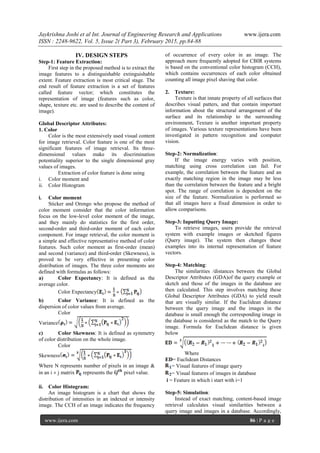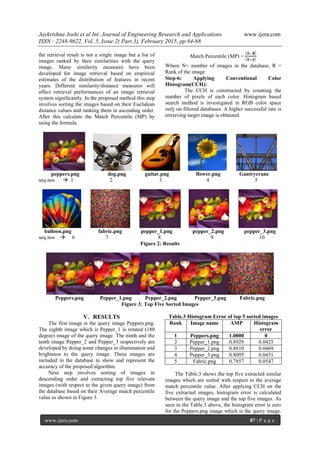The document discusses the need for efficient content-based image retrieval (CBIR) systems due to the rapid growth of digital images. It presents a methodology focused on using global descriptor attributes, such as color and texture features, to improve image retrieval effectiveness. The challenges and solutions in addressing the semantic gap between high-level concepts and low-level visual features in CBIR are also highlighted.
![Jaykrishna Joshi et al Int. Journal of Engineering Research and Applications www.ijera.com
ISSN : 2248-9622, Vol. 5, Issue 2( Part 3), February 2015, pp.84-88
www.ijera.com 84 | P a g e
Global Descriptor Attributes Based Content Based Image
Retrieval of Query Images
Jaykrishna Joshi*, Dattatray Bade**
*(Department of Electronics and Telecommunication, Mumbai University, Mumbai-421 601)
** (Department of Electronics and Telecommunication, Mumbai University, Mumbai-400 037)
ABSTRACT
The need for efficient content-based image retrieval system has increased hugely. Efficient and effective
retrieval techniques of images are desired because of the explosive growth of digital images. Content based
image retrieval (CBIR) is a promising approach because of its automatic indexing retrieval based on their
semantic features and visual appearance. In this proposed system we investigate method for describing the
contents of images which characterizes images by global descriptor attributes, where global features are
extracted to make system more efficient by using color features which are color expectancy, color variance,
skewness and texture feature correlation.
Keywords - Content based image retrieval (CBIR), Retrieval, Query Image, Global Descriptor Attributes and
Color Histogram
I. INTRODUCTION
With the advances in computer technologies and
the advent of the World Wide Web, there has been an
explosion in the amount and complexity of digital
data being generated, stored, transmitted, analyzed,
and accessed. Much of this information is multimedia
in nature, including digital images, video, audio,
graphics, and text data[1]. In order to make use of
this vast amount of data, efficient and effective
techniques to retrieve multimedia information based
on its content need to be developed. Among the
various media types, images are of prime importance.
An image retrieval system is a computer system
for browsing, searching and retrieving images from a
large database of digital images. Most traditional and
common methods of image retrieval utilize some
method of adding metadata such as captioning,
keywords, or descriptions to the images so that
retrieval can be performed over the annotation words.
The reason behind research on multimedia systems
and content-based image retrieval (CBIR) is the fact
that multimedia databases deal with text, audio, video
and image data which could provide enormous
amount of information and which has affected life
style of human for the better.
CBIR is the application of computer vision to the
image retrieval problem, that is, the problem of
searching for digital images in large databases[2].
Content-based image retrieval also known as query
by image content (QBIC) and content-based visual
information retrieval (CBVIR). "Content-based"
means that the search will analyze the actual contents
of the image. The term 'content' in this context might
refer colors, shapes, textures, or any other
information that can be derived from the image itself.
There are some types of feature used for Image
retrieval such as color retrieval, textual retrieval,
shape retrieval and so on. Figure 1 show diagram
fundamental of content-based image retrieval system.
Figure.1 Block Diagram of Basic Content Based
Image Retrieval System
II. CONTENT-BASED IMAGE
RETRIEVAL (CBIR)
Content-based image retrieval (CBIR) has
become one of the most active research areas in the
past few years. Thus, many visual feature
representations have been explored and many CBIR
systems have been built. However, there are several
problems and challenges need to be consider in
attempt to apply CBIR systems. Firstly, the gap
between high-level semantic concept and low-level
visual features is great. In the CBIR context, an
image is represented by a set of low-level visual
features which are the features have no direct
correlation with high-level semantic concept[3].
Human prefer to retrieve images according to the
RESEARCH ARTICLE OPEN ACCESS](https://image.slidesharecdn.com/o502038690-150323041357-conversion-gate01/85/Global-Descriptor-Attributes-Based-Content-Based-Image-Retrieval-of-Query-Images-1-320.jpg)
![Jaykrishna Joshi et al Int. Journal of Engineering Research and Applications www.ijera.com
ISSN : 2248-9622, Vol. 5, Issue 2( Part 3), February 2015, pp.84-88
www.ijera.com 85 | P a g e
“semantic” or “concept” of an image. But, CBIR
depends on the absolute distance of image features to
retrieve similar images Thereby, appear the gap
between high-level concepts and low-level features
which is the major difficulty that hinders further
development of CBIR systems. In other sentence, the
semantic gap problem is the lack of coincidence
between the image representation and the human
interpretation for an image.
There are many existing feature selection
techniques such as distribution based approaches,
Kullback-Leibler divergence (K-LD), boosting
manner, discriminant analysis (DA) method and
others. However, these feature selection techniques
remains a challenging problem for image retrieval. In
recent year, there are a lot of discriminant analysis
method had been proposed and used as a feature
selection method to improve relevance feedback.
These methods included multiple discriminant
analysis (MDA), biased discriminant analysis (BDA),
kernel-biased discriminant analysis (KBDA) and
nonparametric discriminant analysis (NDA). The
goal of discriminant analysis is to find a weight
matrix such that the distances between the two scatter
class matrixes are maximized.
However, these methods have their own
drawback that must be solved to improve the
performance of CBIR[4]. Basic single Gaussian
assumption which proposed by MDA and BDA
usually doesn‟t hold, since the few training samples
are always scattered in the high dimensional feature
space, and their effectiveness will be suffer.
Moreover, single Gaussian distribution means all
positive samples should be similar with similar view
angle and similar illumination, which are not the case
for CBIR. To overcome the problem of single
Gaussian distribution assumption, KBDA had been
introduced. But, this kernel based method has two
major drawbacks which is regularization approach is
often unstable and it is rely on parameter tuning.
Then, NDA had been proposed to solve the problem
in MDA, BDA and also KBDA. This approach can
only barely match the accuracy performance of
KBDA. As a conclusion, many feature selection
methods can not satisfy the requirements in CBIR
even though there are many method has been apply in
content-based image retrieval[5].
III. METHODOLOGY
The term Content-based image retrieval [CBIR]
describes the process of retrieving desired images
from a large collection on the basis of features (such
as colour, texture and shape) that can be
automatically extracted from the images
themselves.Content-based image retrieval, also
known as query by image content and content-based
visual information retrieval is the application of
computer vision to the image retrieval problem, that
is, the problem of searching for digital images in
large databases. „CONTENT BASED‟ means that the
search makes use of the contents of the images
themselves, rather than relying on human-input
metadata such as captions or keywords. The
surrounding world is composed of images.
There are different models for color image
representation. In the seventeen century Sir Isaac
Newton showed that a beam of sunlight passing
through a glass prism comes into view as a rainbow
of colors. Therefore, he first understood that white
light is composed of many colors[6]. Typically, the
computer screen can display 2^8 or 256 different
shades of gray. For color images this makes 2^ (3x8)
= 16,777,216 different colors. Clerk Maxwell showed
in the late nineteen century that every color image
cough be created using three images – Red, green and
Blue image. A mix of these three images can produce
every color. This model, named RGB model, is
primarily used in image representation. The RGB
image could be presented as a triple(R, G, B) where
usually R, G, and B take values in the range [0, 255].
Another color model is YIQ model (lamination (Y),
phase (I), quadrature phase (Q)). It is the base for the
color television standard. Images are presented in
computers as a matrix of pixels. They have finite
area. If we decrease the pixel dimension the pixel
brightness will become close to the real brightness. A
content-based image retrieval system (CBIR) is a
piece of software that implements CBIR. In CBIR,
each image that is stored in the database has its
features extracted and compared to the features of the
query image[7].
Searching and browsing image collections have
become important and active research fields in the
last decade. There are two approaches to image
retrieval: Text-Based approach and Content- Based
approach. Querying by image content is one of most
promising search techniques where users try to find
relevant images based on the given query image.
Color, texture, and shape are the low level features
that are usually preferred in content-based image
retrieval (CBIR) systems. Among these methods,
color histogram is the simplest, yet an effective visual
feature commonly used in color image retrieval[8].
The aim of query-by-color is to find images, whose
color features are similar to the color features of
query image. Although color histograms are
commonly used in computer vision and have the
computational advantages, it is a fact that they are
also very sensitive to small illumination changes and
quantization errors. In proposed method, firstly we
investigate two methods for describing the contents
of the images where first one characterizes images by
global descriptor attributes. Feature vectors based on
color and texture features are called Global
Descriptor Attributes[9].](https://image.slidesharecdn.com/o502038690-150323041357-conversion-gate01/85/Global-Descriptor-Attributes-Based-Content-Based-Image-Retrieval-of-Query-Images-2-320.jpg)


![Jaykrishna Joshi et al Int. Journal of Engineering Research and Applications www.ijera.com
ISSN : 2248-9622, Vol. 5, Issue 2( Part 3), February 2015, pp.84-88
www.ijera.com 88 | P a g e
A histogram error of zero indicates a perfect match.
Thus the retrieved image is same as the query image.
VI. CONCLUSION
The need to find a desired image from a
collection is shared by many professional groups,
including journalists, design engineers and art
historians. While the requirements of image users can
vary considerably, it can be useful to characterize
image queries into three levels of abstraction:
primitive features such as color or texture, logical
features such as the identity of objects shown and
abstract attributes such as the significance of the
scenes depicted. While CBIR systems currently
operate effectively only at the lowest of these levels,
most users demand higher levels of retrieval. Due to
the use of global descriptor values to extract images
the process of retrieval method is much faster than
the conventional approach of retrieval of images.
REFERENCES
[1] “Content-Based Microscopic Image
Retrieval System for Multi-Image Queries”,
Akakin.H.C., Gurcan. M.N, IEEE
Transactions on Information Technology in
Biomedicine, Volume:16, Issue:4 DOI: 10.
1109/TITB.2012.2185829, 2012.
[2] “Generalized Biased Discriminant Analysis
for Content-Based Image Retrieval”, Lining
Zhang, Lipo Wang , Weisi Lin, IEEE
Transactions on Systems, Man and
Cybernetics, Part B: Cybernetics, Volume:
42 , Issue: 1 , DOI: 10.1109/TSMCB.2011.
2165335, 2012.
[3] “Content Based Image Retrieval Using
Unclean Positive Examples”, Jun Zhang ,
Lei Ye, IEEE Transactions on Image
Processing, Volume: 18 , Issue: 10 , DOI:
10.1109/TIP.2009.2026669,2009.
[4] “Interactive content-based texture image
retrieval”, Patil. P.B., Kokare. M.B., 2nd
International IEEE Conference on Computer
and Communication Technology,2011, DOI:
10.1109/ICCCT.2011.6075199.
[5] “Content-Based Image Retrieval for Blood
Cells”, Zare, M.R., Ainon, R.N. , Woo
Chaw.Seng Third Asia International IEEE
Conference on Modelling & Simulation,
2009, DOI:10.1109/AMS.2009.103.
[6] “Image Retrieval Based on Fuzzy Color
Histogram”, Kai-xing Wu, Qiang Xu
International IEEE Conference on Intelligent
Information Hiding and Multimedia Signal
Processing(IIHMSP),2008,DOI:10.1109/IIH
-MSP.2008.57.
[7] “A color based fuzzy algorithm for CBIR”,
Rahmani, M.K.I. , Ansari. M.A, 4th
International Conference on The Next
Generation Information Technology
Confluenc, 2013. DOI:10.1049/cp.2013.23
42.
[8] “Comparative Study on Content-Based
Image Retrieval (CBIR)”,Khan.S.M.H.,
Hussain.A.,Alshaikhli.I.F.T., International
IEEE Conference on Advanced Computer
Science Applications and Technologies
(ACSAT),2012,
DOI:10.1109/ACSAT.2012.40.
[9] “A survey of methods for colour image
indexing and retrieval in image databases”,
R. Schettini, G. Ciocca, S Zuffi, Color
Imaging Science: Exploiting Digital Media,
(R. Luo, L. MacDonald eds.), J. Wiley,
2001.](https://image.slidesharecdn.com/o502038690-150323041357-conversion-gate01/85/Global-Descriptor-Attributes-Based-Content-Based-Image-Retrieval-of-Query-Images-5-320.jpg)